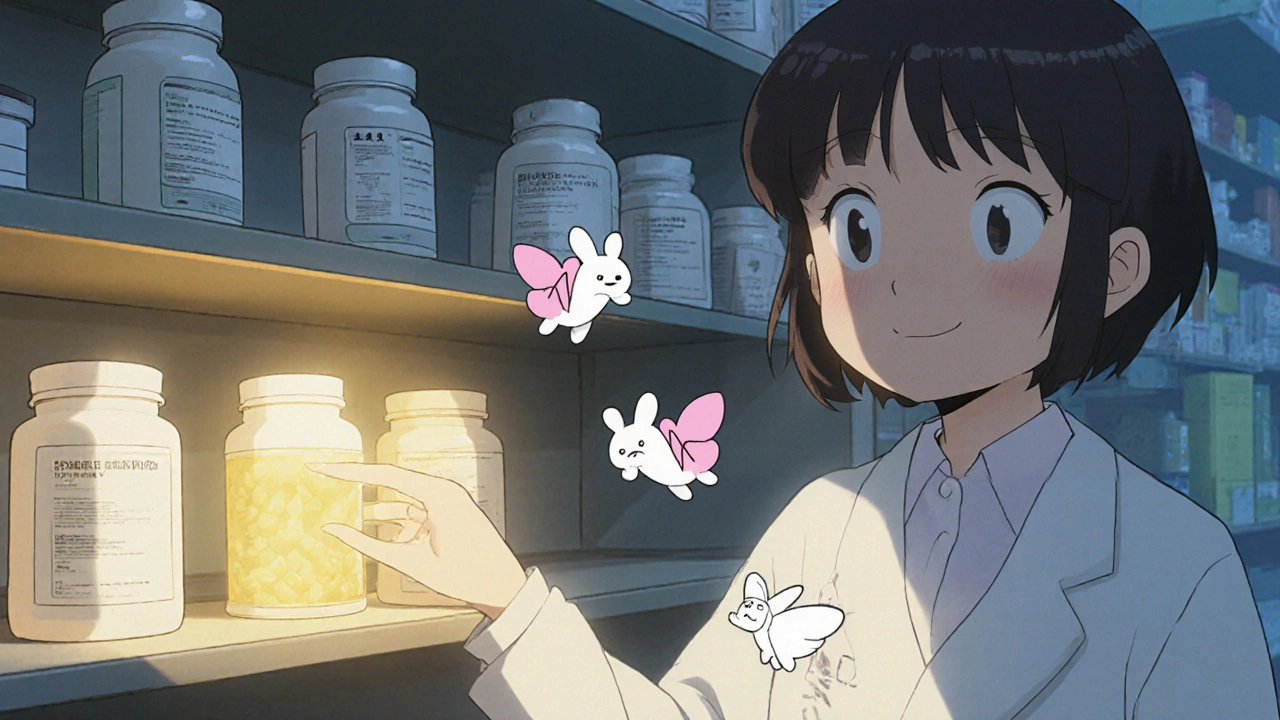Switching from a brand-name drug to a generic version is supposed to save money - and for most people, it does. But for some, it can trigger unexpected reactions or make their condition worse. You might feel fine at first, then notice something off: a rash that won’t go away, sudden fatigue, or your medication just doesn’t seem to work like it used to. These aren’t just "bad luck" or "in your head." They’re real warning signs that need attention.
Why switching to generics isn’t always simple
Generic drugs are required by the FDA to contain the same active ingredient as the brand-name version, in the same strength and form. That sounds straightforward. But what’s not the same? The inactive ingredients - the fillers, dyes, preservatives, and binders that hold the pill together or help it dissolve. These don’t affect how the drug works for most people. But for a small group, they can cause reactions or change how the body absorbs the medicine. This matters most for drugs with a narrow therapeutic index - meaning there’s a tiny window between the dose that works and the dose that’s dangerous. For these, even a small change in how much of the drug gets into your bloodstream can cause serious problems. Examples include:- Levothyroxine (for thyroid conditions)
- Warfarin (a blood thinner)
- Lamotrigine (for epilepsy and bipolar disorder)
- Phenytoin (another seizure medication)
- Valproic acid (for seizures and mood swings)
Warning signs you need to call your doctor within 24 hours
Not every change means trouble. But if you notice any of these after switching to a generic, call your doctor - don’t wait. These are red flags backed by real patient data and clinical reports:- Skin rash, hives, or itching - Especially if it spreads or gets worse. This is the most common reaction, reported in over 14% of adverse events tied to generic switches.
- Persistent nausea or vomiting - Not just a bad stomach day. If it lasts more than two days or you can’t keep food or fluids down, it’s a red flag.
- Unexplained fatigue or weakness - If you’re sleeping more, feeling drained, or can’t do things you used to, it could mean your drug isn’t working right.
- Changes in how well your medication works - Your seizures are coming back. Your migraines are worse. Your mood is swinging. Your blood pressure isn’t dropping. If your condition is no longer under control, that’s not normal.
- New or worsening anxiety, depression, or mood changes - Especially with antidepressants like sertraline or mood stabilizers like lamotrigine. A 2024 analysis of patient reviews showed 37% of reports on sertraline generics mentioned sudden emotional shifts.
Emergency signs: Go to the ER or call 911
Some reactions aren’t just inconvenient - they’re life-threatening. If you experience any of these, don’t call your doctor. Go to the emergency room or call 911 immediately:- Swelling of the face, lips, tongue, or throat - This can block your airway.
- Difficulty breathing or wheezing - Even if it’s mild, it can get worse fast.
- Dizziness, fainting, or a sudden drop in blood pressure - Systolic pressure below 90 mmHg is dangerous.
- Chest pain or rapid heartbeat - Especially if you’re on heart medication like warfarin or clopidogrel.

What to do if you’re on a high-risk medication
If you take one of the narrow therapeutic index drugs listed above, don’t just accept a switch without asking questions. Here’s what to do:- Ask your doctor if your drug is on the high-risk list. Many don’t know the details. Be specific: "Is this a narrow therapeutic index drug?"
- Request a blood test before and after the switch. For levothyroxine, check TSH levels. For warfarin, check INR. For seizure meds, ask for a drug level test. This gives you hard data, not just feelings.
- Don’t let the pharmacy switch you automatically. In 28 U.S. states, pharmacists can swap generics without telling you. California’s law now requires them to notify your prescriber if you’re on certain high-risk drugs. Ask your pharmacist: "Can you hold this prescription until my doctor approves the switch?"
- Keep the original brand-name prescription on file. If things go wrong, you’ll need proof you were stable on the brand. Your doctor can then write a "Do Not Substitute" note.
Not all generics are risky - and that’s the truth
It’s important to say this clearly: for most people, generics are just as safe and effective as brand-name drugs. Studies show no difference in outcomes for common medications like metformin (for diabetes), atorvastatin (for cholesterol), or lisinopril (for blood pressure). A 2021 meta-analysis found the difference in HbA1c control between brand and generic metformin was just 0.04% - practically zero. The problem isn’t generics. It’s automatic substitution without checking if you’re in the small group that might react. Most people switch without issue. But for those who do have problems, the consequences can be serious.
What you can do right now
If you’ve recently switched to a generic and feel off:- Write down exactly what changed - symptoms, timing, severity.
- Check your medication bottle. Is the generic made by a different company than before? Sometimes switching between two different generics can cause issues too.
- Call your doctor. Say: "I switched to the generic and now I’m having [symptom]. I’m worried it’s related. Can we check my levels or go back to the brand?"
- Don’t stop your medication cold. That can be dangerous. Work with your doctor to adjust safely.
Why this matters more than you think
The FDA says generics are equivalent. And for most, they are. But medicine isn’t one-size-fits-all. Your body reacts to tiny differences - in how a pill breaks down, in a dye you’re sensitive to, in how your liver processes the drug. That’s why your experience matters more than any study. Your health isn’t a statistic. It’s your daily life. If something feels wrong after a switch, trust that feeling. You’re not being difficult. You’re being smart.Can I switch back to the brand-name drug if the generic isn’t working?
Yes. If you notice side effects or reduced effectiveness after switching, talk to your doctor. They can write a prescription that says "Do Not Substitute" or "Dispense as Written." Most insurance plans will cover the brand-name version if your doctor documents a medical reason - like a documented change in symptoms or lab results after the switch.
Are generic drugs made in the same factories as brand-name drugs?
Sometimes. Many brand-name companies also make generic versions of their own drugs. Other times, generics are made by different manufacturers, often overseas. The FDA inspects all facilities, but quality can vary. If you notice a change in pill appearance (color, shape, markings) and then start having side effects, it’s worth asking if the manufacturer changed.
Why do some people react to generics but not the brand-name version?
It’s usually the inactive ingredients. One person might be sensitive to a dye or filler in the generic version that wasn’t in the brand. For example, some generics use lactose as a filler - if you’re lactose intolerant, that can cause digestive issues. Others use different coatings that change how fast the drug releases. Your body might handle the brand’s formulation perfectly but struggle with the generic’s.
Is it safe to switch between different generic brands?
For most drugs, yes. But for narrow therapeutic index drugs, switching between different generic manufacturers can cause problems. One study showed patients on lamotrigine had a 25% higher chance of seizures when switching between different generic versions. If you’re on one of these drugs, try to stick with the same generic manufacturer - and ask your pharmacist if they’re changing your prescription.
Can pharmacists refuse to switch me to a generic?
Not always - but they can if your doctor writes "Do Not Substitute" on the prescription. In some states, pharmacists must notify the prescriber before switching for high-risk drugs. If you’re concerned, ask your doctor to add this note when they write your prescription. You have the right to choose what you take.
How long should I wait before deciding if the generic is working?
For most medications, give it 2-4 weeks. But for drugs with narrow therapeutic windows - like thyroid or seizure meds - changes can happen within days. If you feel worse in the first week, don’t wait. Call your doctor. Waiting too long could lead to serious complications.


I switched to generic levothyroxine last year and my TSH went from 2.1 to 8.7 in three weeks. No one believed me until I brought the lab results. Now my doctor won’t let them switch me without a blood test first. Don’t let them gaslight you - your body knows.
Medicine is the last bastion of industrial alchemy - we pour chemicals into pills and pray the soul of the drug survives the journey from patent to pharmacy. Generics aren’t the villain; the system is. We treat patients like units in a spreadsheet while their bodies whisper, ‘Something’s off.’ And we call that progress?
so like... the FDA says they're the same but then people get weird reactions? huh. guess that's why we have lawsuits and class actions. also why do pharmacies even get to switch stuff without telling you? sounds like a scam.
Let’s not romanticize the anecdote. The 15.3% levothyroxine data point? That’s statistically significant but clinically marginal. Most of those patients were noncompliant or had TSH assays with poor precision. And the woman with migraines? Could’ve been stress, caffeine withdrawal, or a placebo rebound. The real risk is overmedicalizing normal variation. You’re not special because your body doesn’t like filler X. Most people don’t care about lactose in a pill - and neither should you.
they’ve been putting tracking chips in generics since 2020. you think the rash is from dye? nah. it’s the nano-antenna in the binder. they’re monitoring your cortisol levels. watch your bloodwork - if your TSH drops right after switching, that’s not the pill. that’s the signal. they know who’s paying attention.
Oh wow, a whole article about how some people might feel weird after switching pills. Groundbreaking. I’m sure the pharmaceutical industry is quaking in their boots. Meanwhile, I’ll be taking my $3 generic metformin and ignoring the drama. If you can’t tell the difference between a brand and generic, maybe you’re just anxious. Or rich.
generic = bad? lmao. i took the generic for 6 months and felt fine. if you feel weird, maybe u r just stressed or eatin junk. also why do u care so much? its just a pill. lol. 🤡
I switched to generic lamotrigine last year and had zero issues. But I totally get why some people do. My cousin had a rash and her doctor immediately switched her back - no argument. Just listen to your body, talk to your doc, and don’t panic. You’re not alone in this.
Has anyone looked into whether the manufacturing location affects reactions? I switched to a generic made in India and got migraines. Switched back to the US-made generic - gone. Coincidence?
The FDA’s bioequivalence standard allows for a 20% variation in absorption - that’s not trivial for drugs like warfarin or levothyroxine. Your doctor should be monitoring therapeutic drug levels after any switch, period. This isn’t opinion - it’s clinical pharmacology. If your provider doesn’t know this, find a new one.
It is imperative to recognize that the structural and chemical composition of pharmaceutical formulations, while ostensibly equivalent under regulatory paradigms, may exhibit subtle but clinically relevant variations in dissolution kinetics, bioavailability profiles, and excipient compatibility across patient populations. The human organism, being a complex and heterogeneous biological system, may respond idiosyncratically to these minor deviations, particularly in the context of narrow therapeutic index agents. Therefore, the presumption of interchangeability - while economically expedient - may constitute a form of medical oversimplification that risks patient safety. A precautionary, individualized approach, supported by therapeutic drug monitoring and patient-reported outcomes, remains the gold standard.
My mom died because they switched her to a generic warfarin without telling us. Her INR spiked to 8. She bled out in the ER. The pharmacy didn’t even call the doctor. This isn’t a ‘warning sign’ - it’s a murder by bureaucracy. And now they’re selling this as ‘savings.’